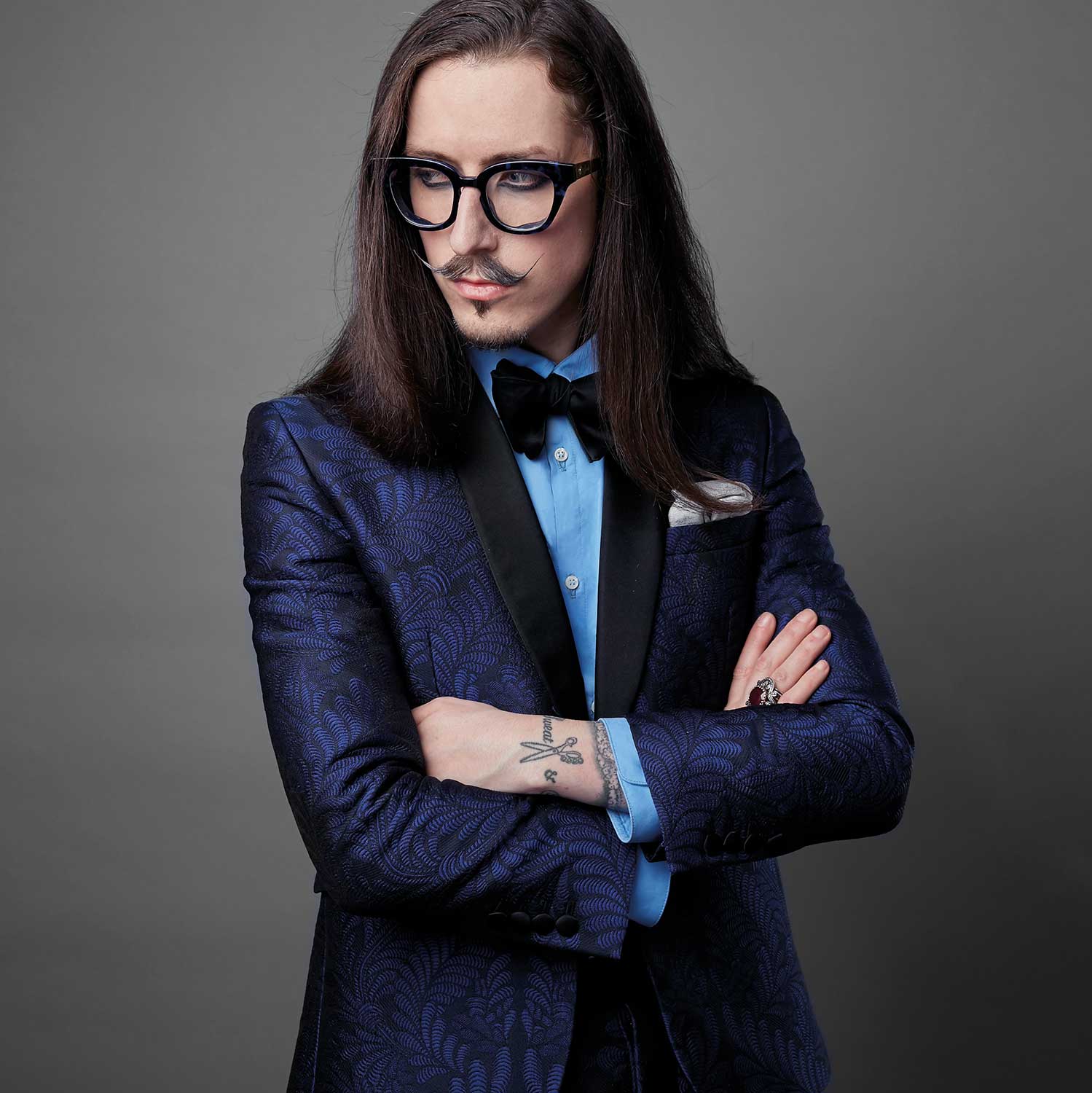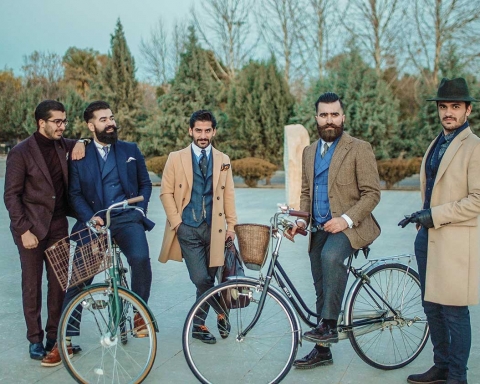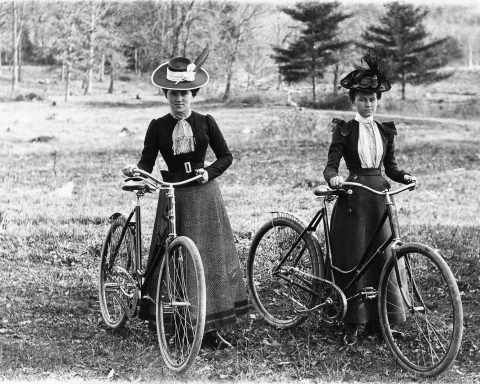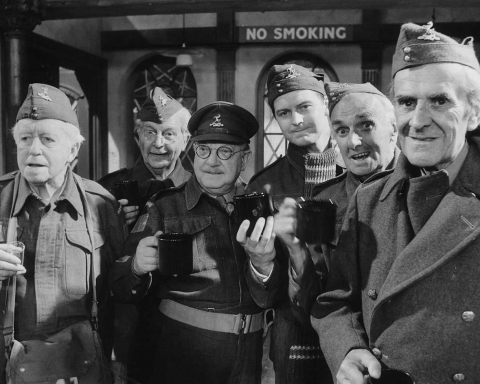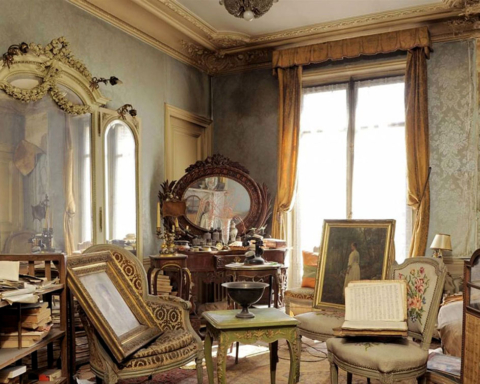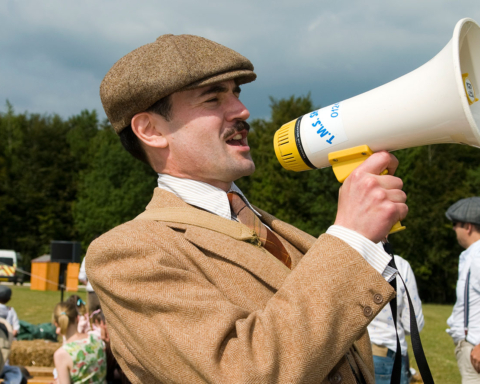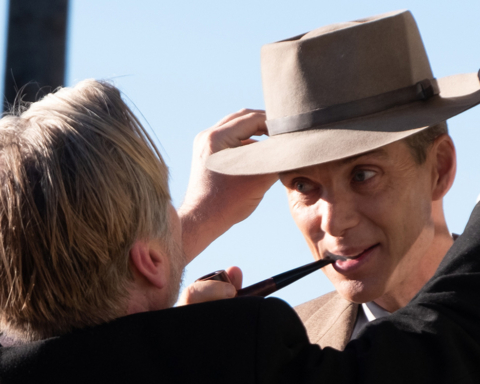Darcy Sullivan:
Poised like a tiny sparrow on Mr. Joshua Kane’s upper lip is a miracle of moustachery. Immaculately chiselled, it recalls the rapier-like moustache Alain Delon wore as Proust’s Baron Charlus in Swann in Love. It is surprising to learn that this Mephistophelean marvel is shaped not by some perfumer’s concoction but by Clubman, a cheap American brand.

“I get sent so many free moustache waxes, and I say thank you but I will never every try another product,” Kane says. “Clubman gives me what I want in a moustache — very defined, very slim, pointed. And it washes out easily.”
One cannot fault a man for his wax choice, but Kane’s low-rent stiffener seems strangely at odds with his brand. After all, Joshua Kane has become known for achingly beautiful men’s clothing that evokes the spirit of dandyism. In just three years, he has taken his brand from a cult oddity to an emerging star in luxury menswear. But then Kane himself embodies the curious contradictions of his clothing lines. He may dress like a Proustian rake, but peeping out of his shirt sleeves are the edges of tattoos that cover his arms. There’s a hilarious photo of him airborne after a misjudged skateboard twist, wearing one of his signature three-piece suits and a high-crowned fedora.
With all this youthful vim wedded to old-school tailoring chops, it’s no surprise that Joshua Kane has been called the next Alexander McQueen. His clothes grab the eye. Suits in jacquard prints, wide-lapelled coats built for sashaying, double-breasted waistcoats that would look swell at a ball in Eugene Onegin, lush velvets and swirling silks. His look is flamboyant and theatrical but grounded in the tailoring tradition. If you ever have to fight a duel, you’d want to do it in Joshua Kane.
A Different Brand of Dandy
The Pitti Uomo menswear festival has brought Italian sprezzatura on to style blogs and fashion pages, creating a peacock army that waves its trendy tail feathers at any passing camera. Men haven’t flaunted this much colour and show-off excess since the early 19th century, when French foppery was all the rage. Joshua Kane’s rise owes something to this dandy revival, but his first influence was the man who ended the peacock era 200 years ago.

“Beau Brummell was the original dandy,” Kane says. “At a time when everyone dressed like the nobility, he was the first to go to his tailor and say, right, I’m not going to dress like the Prince of Wales. I want my suit cut like this, my pantaloons cut like this, my shirts cut like this, my waistcoat like this. He became a style icon by doing it his way. What better story can you want to follow?”
Brummell nearly eradicated colour and focused on shape, line and sober contrasts, creating (or at least popularising) a look that evolved into today’s business suit. Joshua Kane isn’t going for that strict a look — you couldn’t wear most of his clothes to the office, unless you work on Ripper Street. But you can see the moderating influence of classic tailoring, both the British bespoke look and the formal elegance of Brooks Brothers, where Kane worked as a design assistant in 2006. He also learned his trade at Jaeger, Burberry and Paul Smith before launching his own line in 2014.
You can also see a lot of military influences in his work. Today the dandy and the soldier are polar opposites, but this wasn’t true in the 19th century. Even Beau Brummell was proud to serve in the 10th Light Dragoons — at least until they were posted to Manchester. “If you look at the history of modern tailoring, it’s arguably 100 percent from military,” Kane says. “The shape and width of the lapel, how pockets are constructed, the height of armholes, the circumference of sleeves — it’s military through and through. I am never afraid to go too military.”

One of the showstoppers from this year’s “Journey” collection is the Grand Admiral’s Coat, made in a heavy wool cloth with gold lattice braiding, and featuring gold-domed military buttons and lapels like a condor’s wings. Imagine Admiral Nelson outfitted by Tommy Nutter.
Of course, there are less aggressive influences in Kane’s work. Kane says his first womenswear collection was inspired by the complex relationship between Oscar Wilde and Lillie Langtry. His look mixes a strong Edwardian/Victorian influence with the fundamentals of tailoring and luxurious fabrics, all of which Kane has produced for his line. While his clothes are dramatic and often wild, there’s nothing trendy about them.
So who is the Joshua Kane customer? “I appeal to certain individuals who are not catered to or considered,” Kane says. “Fashion is crazy now — you’ve got celebrities with their own Instagram following creating their own design labels. Rather than designers, people with vision, craftsmen leading the forefront, now it’s all about money, it’s all about business. It’s lost its soul and its desirability, in my opinion. At Joshua Kane, we’re reaching individuals who like art, craft, fashion, tailoring, design. The people I would like to attract feel they’re doing more than just buying clothes, they’re purchasing a piece of art. No one needs more clothes. You’ve got enough clothes.”
When Fashion Meets Theatre
Two events so far in 2017 highlighted Kane’s ambitions. In January, he moved his shop from Spitalfields in East London, where he’d been since 2014, to the tony Fitzrovia area, above Oxford Street. In Spitalfields, his shop rubbed shoulders with vintage markets and food stalls; now it’s a skip and a jump from Savile Row. “I love Spitalfields, but sometimes we would have a customer walk in, say they love our look, ask how much something cost and then have an adverse reaction,” Kane says. “Since our move, we have not had that happen once. If people are drawn in by the aesthetic, they get it. Once they know what we’re producing, and where, and at what level of quality, they think it’s a fabulous price.”

Shortly after his new store opened, Kane staged his fourth and largest runway show, at the London Palladium theatre. With more than 2,000 people in the audience, it was billed as London Fashion Week’s biggest show ever. It was certainly one of the most theatrical, with an onstage string quartet replacing the robotic thump-thump of catwalk Eurodisco, and a ballet performance by two dancers from the Central School of Ballet. The audience ranged from fashion glitterati to Made in Chelsea stars, ensuring that to get in you had to elbow your way through paparazzi, celeb-seekers and film crews. It felt more like attending a film premiere than a runway show, except that you didn’t have to be famous to get in — Kane threw the doors open to his brand’s fans.
The centre of the drama was Kane’s “Journey” collection, modelled by a parade of dandies, some of them pouting so fiercely they resembled teenagers whose parents had told them, “You’re not going out in that, young man!” The audience loved it. “That was a tremendous step,” Kane says. “Our first runway, in AW 15, was a 14-piece men’s collection, with 245 people in a small event space in Shoreditch. Now we’ve done a 46-piece, half-men, half-women show for more than 2,000 people at a West End theatre. People in retail say we’ve made 10 years’ worth of progress in just three years.”

As the Joshua Kane brand grows, so does Kane’s personal fame. Clad in his finery, moustache erect, he’s eminently recognizable. That’s good for the business, but has its disadvantages. If you see Joshua and he’s not wearing one of his pimptastic white Gostick hats, here’s why: “There’s something about a white hat that makes people think they can touch it,” Kane explains. “I’d be in a club and people would come up and just start touching my hat. I’d be saying, ‘What are you doing? Don’t touch my hat!’ ”

You can view the collection at www.joshuakanestore.com. If you’re in London, you can find Joshua Kane — the store and, most likely, the man — at 68 Great Portland Street.

